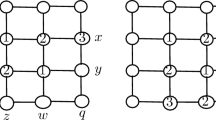Abstract
The paper is concerned with the classical problem concerning the chromatic number of a metric space, i.e., the minimal number of colors required to color all points in the space so that the distance (the value of the metric) between points of the same color does not belong to a given set of positive real numbers (the set of forbidden distances). New bounds for the chromatic number are obtained for the case in which the space is ℝn with a metric generated by some norm (in particular, l p) and the set of forbidden distances either is finite or forms a lacunary sequence.
Similar content being viewed by others
References
L. A. Székely, “Erdős on unit distances and the Szemerédi-Trotter theorems,” in Paul Erdős and his Mathematics, II, Ed. by G. Halasz (Springer, Berlin, 2002), pp. 649–666.
A. M. Raigorodskii, “Borsuk’s problem and the chromatic numbers of some metric spaces,” Usp. Mat. Nauk 56(1), 107–146 (2001) [Russian Math. Surveys 56 (1), 103–139 (2001)].
J. Pach and P. K. Agarwal, Combinatorial Geometry (Wiley, New York, 1995).
V. Klee and S. Wagon, Old and New Unsolved Problems in Plane Geometry and Number Theory (Math. Assoc. America, Washington, DC, 1991).
A. Soifer, “Chromatic number of the plane: a historical essay,” Geombinatorics 1(3), 13–15 (1991).
A. Soifer, Mathematical Coloring Book (Center for Excellence in Mathematical Education, Colorado Springs, CO, 1997).
A. Soifer, The Chromatic Number of the Plane: Its Past, Present, and Future (MTsNMO, Moscow, 2004) [in Russian].
I. Z. Ruzsa, Zs. Tuza, and M. Voigt, “Distance graphs with finite chromatic number,” J. Combin. Theory Ser. B 85(1), 181–187 (2002).
Y. Katznelson, “Chromatic numbers of Cayley graphs on ℤ and recurrence,” Combinatorica 21(2), 211–219 (2001).
R. K. Akhunzhanov and N. G. Moshchevitin, “On the chromatic number of the distance graph associated with a lacunary sequence,” Dokl. Ross. Akad. Nauk 397(3), 295–296 (2004) [Dokl. Math. 70 (1), 543–544 (2004)].
H. Fürstenberg, Y. Katznelson and B. Weiss, “Ergodic theory and configurations in sets of positive density,” in Mathematics of Ramsey Theory (Springer, Berlin, 1990), pp. 184–198.
J. Bourgain, “A Szemeredi type theorem for sets of positive density in ℝk,” Israel J. Math. 54(3), 307–316 (1986).
A. M. Raigorodskii, “On the chromatic number of a space with the metric l q,” Usp. Mat. Nauk 59(5), 161–162 (2004) [Russian Math. Surveys 59 (5), 973–975 (2004)].
J.-H. Kang and Z. Fűredi, “Distance graphs on ℤn with l 1-norm,” Theoret. Comput. Sci. 319(1–3), 357–366 (2004).
D. G. Larman and C. A. Rogers, “The realization of distances within sets in Euclidean space,” Mathematika 19, 1–24 (1972).
A. M. Raigorodskii, “The Erdős-Hadwiger problem and the chromatic numbers of finite geometric graphs,” Mat. Sb. 196(1), 123–156 (2005) [Sb. Math. 196 (1–2), 115–146 (2005)].
Y. G. Chen and T. W. Cusick, “The view-obstruction problem for n-dimensional cubes,” J. Number Theory 74(1), 126–133 (1999).
B. de Mathan, “Numbers contravening a condition in density modulo 1,” Acta Math. Hungar. 36(3–4), 237–241 (1980).
A. D. Pollington, “On the density of sequence n k θ,” Illinois J. Math. 23(4), 511–515 (1979).
A. M. Raigorodskii, “On the chromatic number of a space,” Usp. Mat. Nauk 55(2), 147–148 (2000) [Russian Math. Surv. 55 (2), 351–352 (2000)].
Author information
Authors and Affiliations
Additional information
Original Russian Text © N. G. Moschevitin, A. M. Raigorodskii, 2007, published in Matematicheskie Zametki, 2007, Vol. 81, No. 5, pp. 733–743.
Rights and permissions
About this article
Cite this article
Moshchevitin, N.G., Raigorodskii, A.M. Colorings of the space ℝn with several forbidden distances. Math Notes 81, 656–664 (2007). https://doi.org/10.1134/S0001434607050112
Received:
Accepted:
Issue Date:
DOI: https://doi.org/10.1134/S0001434607050112



